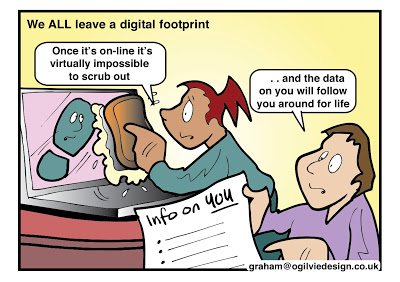Digital Identity: The Big Bad Web & Why It Needs You

*This blog post is the second portion of a two-part collaborative post between myself and Mary Bertram. Head over to her blog, Prairie Inspiration, to see the first portion of this post on digital identity, online presence and reasons to join the online education community.

 |
| #ISRU11 – We ALL leave a digital footprint by OllieBray. Flickr Image at: http://www.flickr.com/photos/olliebray/5542813754/ |
– There are countless platforms online that are designed for networking,
file sharing, etc and it can be a little overwhelming at the start. Find one
or two platforms that fit what you are looking for or that you are most
comfortable with and begin developing your digital identity from there.
– If you choose too many it is easy to get bogged down and not gain anything
meaningful from them. If you have been online for a while, start going through
the multiple platforms that you’ve signed up for, update the ones you want to
use and disable the ones you don’t use anymore.
– Make sure that whatever information you include matches the standard
identity that you maintain across all of your online platforms.
– Privacy controls are especially important if you are using certain platforms
for personal use and others for professional use. It is one thing to have a
public Twitter account which you use professionally to develop a PLN and
having a public Facebook account which you use personally to post pictures
of your weekend activities.
* Use your professional judgement to determine what privacy levels your
platforms need.
– It is really easy to get sucked into signing up for multiple tools once you’re
online but it can quickly get overwhelming to maintain. Until you feel very
comfortable with the digital identity that you want to establish, try to limit
yourself to a few platforms that you use well as opposed to signing up for
everything and letting your digital identity suffer.
– Remember to use your standard identity each time you create a new account.
– Once you are comfortable with the platform that you have chosen and have
“lurked” around for a while you should begin making connections and building
your network. Think about what you want to get out of your experience and
connect with people who can help you reach your goals.
– For example, if you are on Twitter and teach high school Chemistry, you may
begin to follow other educators, chemistry departments from various universities,
chemistry resources for students and/or find applicable hashtags like #education,
#chemistry and #chemchat.
* It is okay for your network to change as your needs and goals change.
– If you want to have a positive online experience and get the most out of your
network make sure that you use proper etiquette and pay it forward whenever
possible.
– To get the most out of your online experience and help solidify your digital
identity it is not enough to simply be a consumer of information. The best
networking opportunities and learning experiences occur when you are an
active part of the process and contributing to the experience.
– This can be as simple as passing along helpful resources to others in your
network or as complex as creating your own videos/blogs/podcasts/etc.
– One of the most important tips to remember, online and offline, is that your
behaviour must reflect the standards outlined in your Code of Professionalism.
It can be easy to assume that you are anonymous when it comes to online
behaviour but in order to develop a professional digital identity and have a
positive online presence then your Code of Professionalism must always be
in your mind.
– To review the Code of Professional Practice, as outlined by Manitoba Teachers’
1 ) Google+
– We recommend Google+ For Educators: LiveBinder created by
Steven Anderson
– To read about an educator’s experience with Google+, see Will
Deyamport’s post (with video!): Google What? Google+
My MECA 2013 Presentation
2 ) Twitter
– We recommend Twitter for Educators: A Beginner’s Guide created by Amber Coggin
– To read about my experience with Twitter, see my post: Twitter… 1 Year Later
3 ) LinkedIn
– We recommend Social Networking Part 3: Teachers Guide to the Use of LinkedIn
created by Med Kharbach.
4 ) Facebook
– We recommend the Facebook for Educators Guide put out by Facebook themselves
and The Complete Guide to Facebook for Educators by Lisa Nielsen.
_________________________________________________________
To read Part 1 of this post on digital identity, online presence and reasons to join the online education community. Head over Mary Bertram’s blog, Prairie Inspiration.
To read more about Digital Citizenship: Identity, Footprint & Social Activism, read some of the great posts by the #ETMOOC community.
*If you would like to see what I found when I Googled myself, see my post: My Digital Footprint.
**Remember to always maintain a standard identity online; whether you are using a social networking site like Twitter or a file sharing site like SlideShare.